Scottish Marine and Freshwater Science Volume 5 Number 15: Development of a Sampling Programme and Measurement of Contaminants in Food for Marine Strategy Framework Directive Descriptor 9
Descriptor 9 (contaminants in food) is one of eleven Marine Strategy Framework Directive (MSFD) qualitative Descriptors to be used in determining whether Good Environmental Status (GES) has been achieved for European regional seas (Directive EC/2008/56).
Sampling Design for MSFD Descriptor 9
Objectives
Although existing contaminant data for fish and shellfish held by MSS, SEPA and FSAS suggests that concentrations are mainly below the regulatory levels, much of the fish data are unsuitable for use in assessments for Descriptor 9. Current environmental monitoring programmes are not designed to assess whether concentrations in fish for human consumption are of concern at the (sub) regional level. In particular, the programmes have limited spatial coverage and the species and matrix sampled are rarely those most relevant to human consumption. To surmount this, a sampling programme for fish should be designed for Descriptor 9 purposes. The design should target those species most destined for human consumption and ideally should sample fish in a way that is representative of the spatial and temporal distribution of the landings of the commercial fishery.
The GES target and indicators for contaminants in seafood proposed by the UK:
For contaminants where regulatory levels have been set, there should be a high rate of compliance based on relevant surveys and including samples originating from commercial fishing grounds in the greater North Sea and the Celtic Seas 3.
is extremely vague. A 'high rate of compliance' is interpreted here as:
The 95 th quantile of the distribution of concentrations [of a contaminant] in the edible parts [muscle] of the landings [of a species] should be below the regulatory limit.
That is, the concentrations in 95% of landed fish should be below the regulatory limit. Adopting a precautionary approach, sampling will be designed so that, given current estimates of mean concentrations, there is a 90% power of demonstrating that the 95 th quantile is significantly below the regulatory limit based on a test at the 5% significance level.
There are two types of design that would provide the data to estimate the 95 th quantile of concentrations in the landings and that might be achieved at acceptable cost by extending existing monitoring activities. The first is to sample fish landings at market throughout the year as part of the MSS market sampling programme. By timing sampling occasions correctly, the samples would be representative of the temporal distribution of landings. However, ensuring representative spatial coverage would be more difficult, as it is hard to predict where the fish on market will come from (at a finer resolution than the sub regional scale) before visiting the market. The logistics of organising such a programme would also be quite complex and would increase costs. Finally, there would be no control over the treatment of the fish between the time of capture and of sampling ( i.e. when they are landed) so there is the possibility of additional contamination.
The alternative, which is developed further below, is to collect fish during the annual MSS research vessel surveys that provide indices of abundance for fish stock assessment. This is much simpler and would ensure representative spatial coverage by sampling from trawl locations with probability proportional to the commercial landings. However, it will only give a snap-shot of contaminant levels in fish for human consumption at the time of the survey. It is thus important to ensure that the survey is during a period when landings are relatively high and when contaminant levels are not unduly low due to seasonal variation.
Sampling Areas
The MSFD (Article 4) lists ten sub-regions for monitoring purposes and the report of the ICES/ JRC Task Group for Descriptor 9 lists the most consumed species in each. The relevant sub-regions for the UK are:
- The Greater North Sea, including the Kattegat and the English Channel ( OSPAR Region II).
- The Celtic Seas ( OSPAR Region III).
Scottish waters fall within OSPAR Region II (includes the Scottish sea areas East Shetland, Fladen, Moray Firth, East Scotland Coast, Forties, and Forth) and OSPAR Region III (includes the Scottish sea areas Solway Firth and North Channel, Clyde, Minches and Malin Sea, Hebrides, Rockall, Bailey, North Scotland Coast, Faroe-Shetland, West Shetland).
MSS conducts annual bottom trawl surveys in the North Sea ( OSPAR Region II) in Quarter 1 (January-March) and Quarter 3 (July-September). These surveys provide data that are used in the assessment of fish stocks in ICES Area IV. The spatial extent of each survey differs slightly but, for Descriptor 9 purposes, both surveys can be used to sample Scottish waters in the North Sea as defined in Figure 3. There are also annual bottom trawl surveys to the West of Scotland ( OSPAR Region III) in Quarter 1 and Quarter 4 (October-December) that provide abundance indices for ICES Division VIa ( Figure 3). Division VIa extends beyond Scottish waters but, for simplicity, is regarded as the sampling area for Descriptor 9. For simplicity, we refer to these sampling areas as North Sea and West of Scotland.
Figure 3 North Sea and West of Scotland D9 sampling areas.
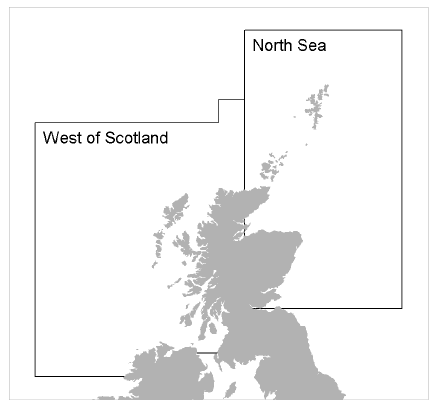
Target Species
The ICES/ JRC Task Group report for Descriptor 9 4 states that:
- In order to make monitoring results more comparable between (sub) regions, it would be advisable to select a limited number of target species from the most consumed species of fish and other seafood using the table in Annex II.
- General criteria for the selection of the species to be used for monitoring include species more prone to bio-magnify/bio-accumulate specific classes of contaminants, species representative of the different trophic levels or habitats, species representative for (sub) region.
Species for monitoring for Descriptor 9 should be selected using the list of most consumed species in OSPAR regions, presented in the ICES/ JRC Task Group report 4. Landings by Scottish vessels in the UK and abroad for 2012 have been reported 13 and are shown in Table 2 for species listed as being important in OSPAR Regions II and III.
The ability to accumulate contaminants should also be taken into account. Species with a higher lipid content and higher trophic status are likely to accumulate higher concentrations of contaminants. Trophic levels and the lipid content of the commercially relevant species are shown in Table 2. The lipid content can be classed as lean (0-2 %), medium fat (2-7%), fat (7-15%) and high fat (>15%) 18. Factors such as migratory pattern and reproductive cycle can affect lipid content. In particular, fish have less lipid whilst spawning.
Landings by Scottish vessels into the UK and abroad 13 and importance in OSPAR Regions II and III along with trophic level and lipid content class. The importance categories (+, ++ or +++) are taken from the ICES/ JRC Descriptor 9 task Group report 4. If the importance for Region 2 and 3 is different, then the Region 2 importance is shown first. Landings for the main species (total value landed > £2 million) are also shown by ICES areas (IVa and IVb - North Sea and VIa, VIb - West of Scotland) 13.
| Common Name | Species | Importance in OSPAR regions II & III 4 | Scottish landings 2012 (tonnes) 13 | Trophic Level 12 | Lipid Content Class a | |
|---|---|---|---|---|---|---|
| North Sea | West of Scotland | |||||
| Herring | Clupea harengus | +++ | 33,640 | 8,369 | 3.2 | fat |
| Cod | Gadus morhua | +++ | 10,565 | 146 | 4.4 | lean |
| Hake | Merluccius merluccius | +++ (Region III only) | 3,122 | 2,601 | 4.4 | lean |
| Haddock | Melanogramus aeglefinus | +++ (Region III only) | 25,528 | 4,661 | 4.1 | lean |
| Monkfish | Lophius spp | +++ (Region III only) | 4,637 | 2,074 | 4.5 | lean |
| Megrims | Lepidorhombus spp. | +++ (Region III only) | 1,378 | 675 | 4.2 | lean |
| Whiting | Merlangius merlangus | +++ (Region III only) | 8,717 | 203 | 4.4 | lean |
| Mackerel | Scomber scombrus | +/+++ | 57,282 | 66,393 | 3.7 | fat |
| Sole | Solea solea | +/+++ | 3.1 | lean | ||
| Pollack | Pollachius pollachius | ++ (Region III only) | 4.2 | lean | ||
| Sprat | Sprattus sprattus | + /++ | 3.0 | fat | ||
| Plaice | Pleuronectes platessa | + /+++ | 2,845 | 39 | 3.3 | medium fat |
| Saithe | Pollachius virens | + /+++ | 5,485 | 4,541 | 4.4 | lean |
a lean, <2%; medium fat, 2-7%; fat, 7-15%; high fat, >15% 18.
Mackerel and herring, both pelagic species, are commonly found in OSPAR Regions II and III and have the highest landings by Scottish vessels ( Table 2). Appendix 1 shows the spatial distribution of landings by vessels into Scotland during 2013. Herring are fished primarily to the north of Scotland whereas mackerel are fished over a wider area, reflecting their broader geographical distribution. For herring, landings are highest in the North Sea (33,640 tonnes in 2012) and for mackerel landings are similar in the North Sea (57,282 tonnes in 2012) and West of Scotland (66,393 tonnes in 2012). However, both species are migratory, mackerel more so than herring. Mackerel migrate from the spawning areas west of Ireland that they occupy from March through to July to the Viking bank area of the North Sea for the winter. Mackerel have the potential to move between the coast of northern Spain and the northern Norwegian Sea. Herring stocks are less mobile, but migrate within areas such as the west of Scotland or the North Sea. Although fish sampling for contaminant analysis should usually be outside the period of spawning, when fish are in a stable physiological state 19, this is not necessarily the case for Descriptor 9, particularly if the landings are greatest during the spawning season. Although herring can be found spawning in almost any month, around Scotland the majority spawn in the autumn, between August and October (North Sea and West Scotland). The lipid content of herring and mackerel muscle are in the range of 7-15%, and, therefore, they will have a higher potential to accumulate contaminants than lean species such as haddock and cod.
Of the demersal species, haddock and cod have the highest total landings by Scottish vessels, 30,189 and 10,711 tonnes respectively. For both species, landings from the North Sea are greater than from the West of Scotland 13. Seasonal migrations of cod populations can take place, but in most areas feeding and spawning movements are limited. Similarly, haddock do not exhibit long migratory behaviour. Both cod and haddock muscle have a low lipid content (<2%). Monkfish have moderate landings by Scottish vessels and are found in both North Sea and West of Scotland grounds. They have a long spawning season, which takes place mainly during the first six months of the year, mostly in relatively deep water (150-1,000 metres).
Norway lobster (N ephrops norvegicus, also known as langoustine or Dublin Bay Prawn) is the most fished crustacean species, with Scotland having the largest Nephrops fishery in the world and the fishery being the second most valuable (at ca.£80 million p.a.) to Scotland after mackerel 20. Adult Nephrops are non-migratory, spending most of their time in burrows in soft muddy sediment, except when feeding or to look for a mate. Due to the relationship between contaminant concentrations and sediment grain-size and organic carbon content, benthic organisms living in fine grained sediments may be more likely to accumulate contaminants than epibenthic or pelagic species. The largest Scottish fisheries in the North Sea are the Fladen Ground (~10,000 t p.a., ca.50% of North Sea catch), Firth of Forth and the Moray Firth; the North Minch, South Minch and Firth of Clyde on the West coast have similar sized fisheries (5-6000 t p.a.).
The target species for a Descriptor 9 sampling programme in both the North Sea and West of Scotland will, therefore, be haddock (high landings, high trophic level, limited migration, lean), herring (high landings, moderate trophic level, moderate migration, high lipid content), and monk (moderate landings, high trophic level, limited migration, lean). The individuals sampled should be of marketable size:
Haddock ≥30 cm ( EC Regulation 850/98)
Herring: ≥20 cm ( EC Regulation 850/98)
Monk: ≥500 g ( EC Regulation 2406/96)
Nephrops: ≥25 mm carapace length (20 mm in the Clyde 21)
Stylized Sampling Design
This section describes the sampling design for a stylized fish survey in which the sampling area is sub-divided into S strata and there is a single haul in each stratum. Later sections then describe how the design was adapted and implemented for haddock, monk and herring, given the features of the bottom trawl surveys available.
Let L s be the commercial landings (of a particular species) from stratum s, and let

be the proportion of the total landings that came from stratum s. A representative sample of the landings is obtained by sampling from each stratum with probability proportional to p s. This ensures that areas are sampled more frequently if they are more important to the fishery. The required number of fish from (the single haul in) each stratum is generated by simulating from a multinomial distribution

where n is the total number of fish required (see below). Note that there is no unique allocation of fish to strata because the numbers are randomised: each simulation will generate a different design.
There are limited data on which to base the sample size n. Ten haddock, monkfish and herring were sampled on the Quarter 4 bottom trawl survey to the West of Scotland in 2012. The monkfish and herring were from a single haul and the haddock from five hauls, so there is no information about spatial variability in concentrations for the former two species, and only limited information for the latter. The muscle of each fish was analysed for metals. There are regulatory levels for mercury (500 µg kg -1 for haddock and herring; 1000 µg kg -1 for monk), cadmium and lead (50 and 300 µg kg -1 respectively for all three species) ( Table 1). All but one of the measured cadmium and lead concentrations were below the detection limits of 4.76 and 13.6 µg kg -1 respectively so, whilst reassuringly low, do not help much for design purposes. Assuming the mercury concentrations for each species are log-normally distributed, Table 3 shows the estimated median concentration, the standard deviation in log concentration, the 95 th quantile, and the upper 95% confidence limit on the 95 th quantile. The quantile and its upper confidence limit were estimated by maximum likelihood and profile likelihood methods respectively.
Median mercury concentration (µg kg -1), with standard deviation of log concentrations, 95 th quantile with upper 95% confidence limit, and regulatory limit.
| median | standard deviation | 95 th quantile | confidence limit | regulatory level | ||
|---|---|---|---|---|---|---|
| Mercury | herring | 61 | 0.68 | 186 | 350 | 500 |
| monkfish | 139 | 0.55 | 344 | 578 | 1000 | |
| haddock | 107 | 0.31 | 177 | 236 | 500 | |
For mercury, the 95 th quantiles are significantly below the regulatory level. This cannot be taken as proof of GES as the fish were taken from only a few locations (only one for herring and monkfish) but the estimates can be used to choose a sensible value of n. Table 4 shows the probability that the 95 th mercury quantile will be significantly below the regulatory level for different values of n, assuming the median concentration and standard deviation in Table 4. The table also shows the corresponding probabilities when the standard deviation is inflated by 1.5 as a pragmatic way of introducing some spatial variation. For the sample standard deviations estimated from the data, a sample size of n = 15 would give 90% power for all three species. If the standard deviations are inflated by 1.5, then 15 fish would still be adequate for haddock, but 50 monkfish would be needed and more than 100 herring. The cost of analysing these higher samples sizes would exceed the budget so, as a compromise, n = 20 fish of each species will be sampled. This gives acceptable power for the levels of variability observed in the data and a modicum of protection against additional spatial variation.
Probability (%) that the 95 th mercury quantile will be significantly below the regulatory level for different sample sizes n and standard deviations. Probabilities greater than 90% are in bold.
| n | Herring | Monk | Haddock | |||
|---|---|---|---|---|---|---|
| sd = 0.68 | sd = 1.02 | sd = 0.55 | sd = 0.83 | sd = 0.31 | sd = 0.46 | |
| 10 | 82 | 26 | 94 | 44 | 100 | 89 |
| 15 | 93 | 32 | 99 | 55 | 100 | 97 |
| 20 | 98 | 35 | 100 | 63 | 100 | 99 |
| 25 | 99 | 40 | 100 | 71 | 100 | 100 |
| 30 | 100 | 43 | 100 | 77 | 100 | 100 |
| 40 | 100 | 51 | 100 | 87 | 100 | 100 |
| 50 | 100 | 59 | 100 | 93 | 100 | 100 |
| 100 | 100 | 84 | 100 | 100 | 100 | 100 |
D9 Sampling in the North Sea
Figure 4 shows the planned haul locations for the 2014 bottom trawl surveys in the North Sea in Q1 and Q3. The sampling area is divided into ICES rectangles with usually one haul in each rectangle. The strata for the D9 survey are, therefore, taken to be the ICES rectangles, with suitable modifications when there are no hauls in a rectangle. Since concentrations would be expected to be positively correlated spatially, rectangles with no hauls were combined with adjacent rectangles until each stratum had at least one haul (see Figure 4). In the tables of D9 sampling designs that follow, each stratum is indexed by the rectangle within it that has a haul.
Figure 4: Planned bottom trawl surveys in ICES Area IV in Quarter 1 (left) and Quarter 3 (right) of 2014. Diamonds indicate haul locations and the thin black lines show ICES rectangles. When designing the D9 sampling, the Q3 haul locations shown in red had not been confirmed, with the red stars indicating possible alternatives. The red lines show where rectangles have been combined into larger strata to ensure that there is at least one haul in each stratum.
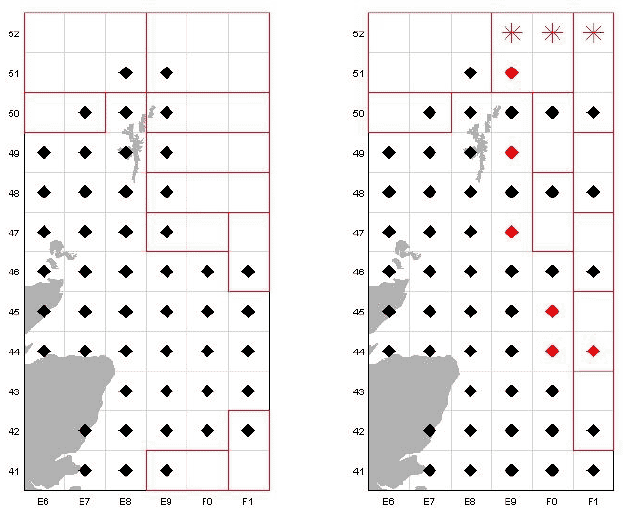
Haddock
North Sea haddock landings were fairly consistent across months in each of the years 2010-2013 apart from a dip in April ( Figure 5). Therefore, either the Q1 or Q3 survey could be used to sample haddock for D9 purposes, since landings are likely to reasonably large at the time of both surveys. The spatial distribution of landings was also reasonably consistent across years with the greatest landings tending to be in the central part of the survey area ( Figure 5) where both surveys will trawl all rectangles. A D9 sampling design ( i.e. number of haddock from each stratum) was generated for the Q1 survey based on the spatial distribution of the landings in 2013 ( Table 5). The Q1 survey was used because, if insufficient haddock were caught, sampling could be repeated during the Q3 survey. It is impossible to ensure that there will be sufficient fish caught on each haul to meet the D9 sampling requirements. To provide some protection against this, a second 'contingency' design was generated. Where possible, these extra fish should also be sampled and used to make up any shortfall in numbers in the primary design.
D9 sampling design for North Sea haddock using the Q1 survey and 2013 landings. The total number of fish is the combined number from the primary and contingency design.
| Statistical rectangle | Landings (tonnes) |
Sampling probability | D9 sample size | Total Fish |
|---|---|---|---|---|
| E9 48 | 2325 | 0.10 | 3 | 7 |
| E9 49 | 1819 | 0.07 | 3 | 7 |
| F0 44 | 827 | 0.03 | 2 | 5 |
| E9 44 | 1428 | 0.06 | 2 | 3 |
| E8 44 | 1309 | 0.05 | 2 | 3 |
| E8 46 | 1440 | 0.06 | 1 | 2 |
| E8 49 | 843 | 0.03 | 1 | 2 |
| E7 45 | 565 | 0.02 | 1 | 2 |
| E7 44 | 796 | 0.03 | 0 | 2 |
| E8 48 | 1473 | 0.06 | 1 | 1 |
| E8 47 | 1276 | 0.05 | 1 | 1 |
| E6 48 | 529 | 0.02 | 1 | 1 |
| E8 50 | 244 | 0.01 | 1 | 1 |
| E7 50 | 222 | 0.01 | 1 | 1 |
| E9 43 | 1441 | 0.06 | 0 | 1 |
| E6 49 | 118 | <0.01 | 0 | 1 |
Figure 5: Haddock landings (tonnes) by Scottish vessels into Scotland from ICES Area IV for 2010-13. Top: monthly landings. Bottom: spatial distribution in the D9 sampling area (2010-2013 from top left).
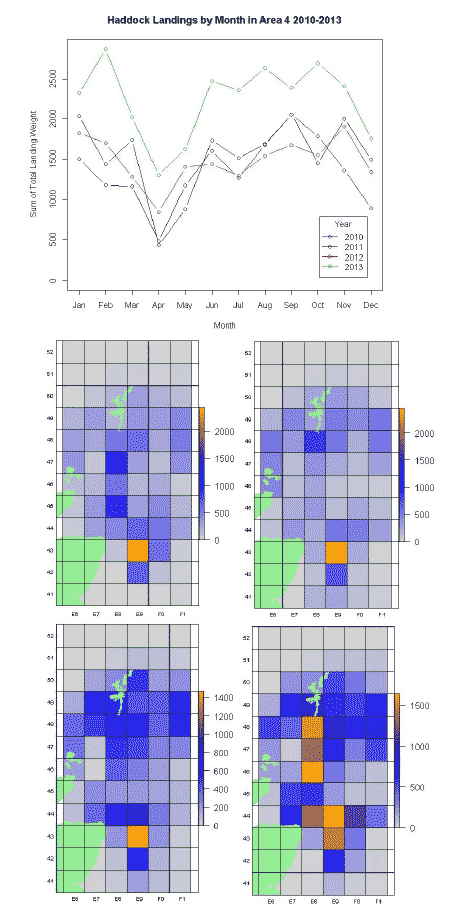
Monkfish
North Sea monkfish landings within the North Sea were reasonable consistent across months for each of the years 2010-2013, although landings were generally highest in Q2 ( Figure 6). For this reason, both surveys would be suitable for D9 sampling. The spatial distribution of landings was also reasonably consistent across years with the greatest landings in the north west of the survey area ( Figure 6). A D9 sampling design was generated for the Q1 survey based on the spatial distribution of the landings in 2013, but only six of the required 20 fish were caught, despite having some contingency sampling. A new design was, therefore, generated for the Q3 survey ( Table 6). Due to potential changes in haul locations during the Q3 survey some statistical rectangles selected in the D9 design may not be trawled. To cover for this, any samples generated for rectangles that may not be trawled were duplicated in a nearby rectangle that will be trawled.
D9 sampling design for North Sea monkfish using the Q3 survey and 2013 landings.
| Statistical rectangle | Landings (tonnes) | Sampling probability | D9 sample size | Total fish |
|---|---|---|---|---|
| E6 49 | 560 | 0.14 | 1 | 8 |
| E6 48 | 332 | 0.08 | 4 | 5 |
| F0 48 | 150 | 0.04 | 3 | 4 |
| E9 50 | 168 | 0.04 | 3 | 3 |
| E9 52 | 77 | 0.02 | 1 | 3 |
| F0 46 | 77 | 0.02 | 1 | 3 |
| E8 51 | 123 | 0.03 | 2 | 2 |
| E8 50 | 124 | 0.03 | 0 | 2 |
| F0 50 | 343 | 0.08 | 0 | 2 |
| E7 49 | 185 | 0.05 | 1 | 1 |
| E7 50 | 194 | 0.05 | 1 | 1 |
| E9 48 | 86 | 0.02 | 1 | 1 |
| E9 51 | 180 | 0.04 | 1 | 1 |
| F1 44 | 26 | 0.01 | 1 | 1 |
| E7 48 | 18 | 0.01 | 0 | 1 |
| E9 45 | 106 | 0.03 | 0 | 1 |
| F0 44 | 65 | 0.02 | 0 | 1 |
Figure 6: Monkfish landings (tonnes) by Scottish vessels into Scotland from ICES Area IV for 2010-13. Top: monthly landings. Bottom: spatial distribution in the D9 sampling area (2010-2013 clockwise from top left).
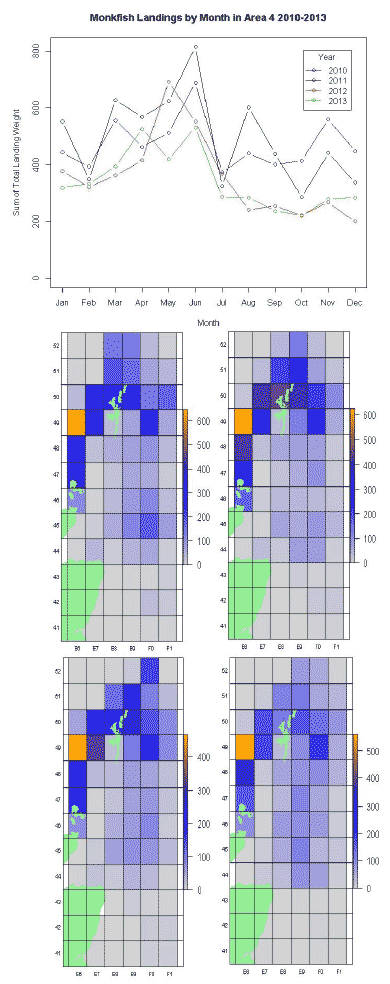
Herring
North Sea herring landings peak in August each year, with high landings between July and September ( Figure 7), so only the Q3 survey is suitable for D9 purposes. The spatial distribution of herring landings for herring varied considerably between years ( Figure 7), presumably due to schooling and the short period of peak fishing activity, with the greatest landings typically somewhere in the north western part of the survey area. To get a more robust prediction of 2014 landings, the D9 survey design was based on the average landings in each rectangle between 2010 and 2013. The sampling requirements are given in Table 7. Due to potential changes in sampling locations during the Q3 surveys (see Figure 4) some statistical rectangles selected may not be sampled. To account for this, any samples generated for rectangles that may not be sampled were duplicated in a nearby rectangle that will remain in the IBTS survey design for contingency.
D9 sampling design for North Sea herring using the Q3 survey and averaged 2010-2013 landings.
| Statistical rectangle | Landings (tonnes) | Sampling Probability | D9 sample size | Total fish |
|---|---|---|---|---|
| E8 47 | 3230 | 0.11 | 4 | 8 |
| E8 48 | 1480 | 0.05 | 2 | 5 |
| E7 46 | 817 | 0.03 | 3 | 3 |
| E9 47 | 1250 | 0.04 | 1 | 3 |
| E9 49 | 1070 | 0.04 | 1 | 3 |
| E9 50 | 1060 | 0.04 | 0 | 3 |
| E8 46 | 603 | 0.02 | 2 | 2 |
| F0 43 | 383 | 0.01 | 1 | 2 |
| F0 46 | 1230 | 0.04 | 0 | 2 |
| E8 49 | 134 | 0.00 | 0 | 2 |
| F0 44 | 991 | 0.03 | 1 | 1 |
| E9 46 | 898 | 0.03 | 1 | 1 |
| F1 46 | 529 | 0.02 | 1 | 1 |
| E7 47 | 2050 | 0.07 | 1 | 1 |
| F0 48 | 2200 | 0.08 | 1 | 1 |
| E7 49 | 376 | 0.01 | 1 | 1 |
| E8 44 | 402 | 0.01 | 0 | 1 |
| F1 44 | 1020 | 0.04 | 0 | 1 |
| E9 45 | 323 | 0.01 | 0 | 1 |
| E6 46 | 575 | 0.02 | 0 | 1 |
| E6 48 | 380 | 0.01 | 0 | 1 |
| E7 48 | 2250 | 0.08 | 0 | 1 |
| F0 50 | 222 | 0.01 | 0 | 1 |
| F1 50 | 997 | 0.04 | 0 | 1 |
Figure 7: Herring landings (tonnes) by Scottish vessels into Scotland from ICES Area IV for 2010-2013. Top: monthly landings. Bottom: spatial distribution in Scottish waters (2010-2013 clockwise from top left).
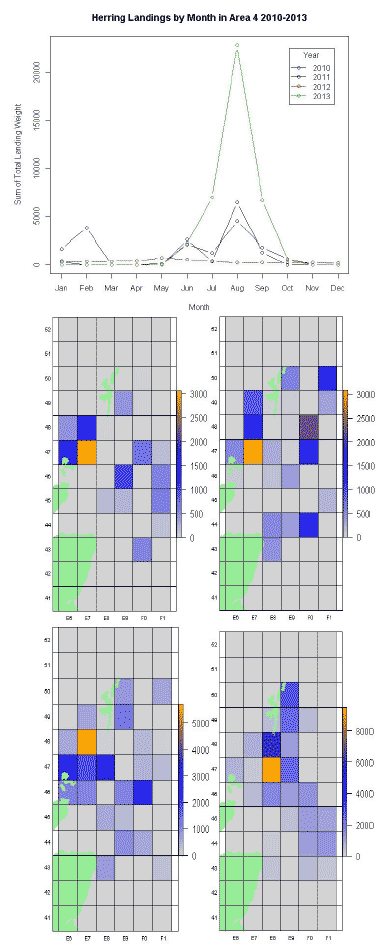
Contact
There is a problem
Thanks for your feedback